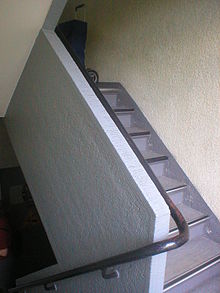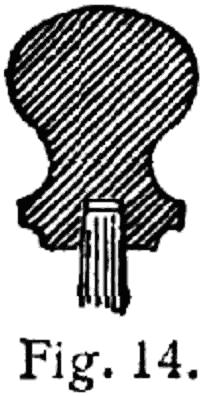Handrail




A handrail is a - mostly profiled or round - possibility of holding and guiding people's hands within easy reach. Handrails are mostly in the form of bars, rails or strips. Common materials are metal, wood, wooden materials or plastic. A handrail can be the top of a railing or parapet . It can also be attached directly to a wall .
conditions
The legislator prescribes a "fixed" handrail. Rope , so handrails rope are meant only as an ornament, since they can yield in a fall. Handrails should preferably be rounded or round and have a diameter of 30 to 45 mm. They should be continuous and, if possible, be led over the first and last step . For round wooden handrails, VOB / DIN 18334 specifies a minimum diameter of 48 mm or, alternatively, a rectangular cross-section of at least 40 × 60 mm.
Handrails on stairs
Handrails are often found in connection with stairs . Whether, where and how many handrails are required by law on a staircase depends on the number of steps ( inclines ), the width of the staircase and the purpose of the respective building. In Germany this is regulated in the state building codes and numerous other ordinances. Special building regulations often require handrails on both sides, e.g. B. in hospitals and old people's homes, in schools and kindergartens, in sales and meeting places, in hotels and restaurants etc.
In publicly accessible buildings, handrails are required on both sides of the stairs so that there is a secure hold on both sides. This regulation also applies to listed buildings, as case law places the safety of users above monument protection . In the state building regulations of the individual federal states, handrails on both sides are often prescribed for all necessary stairs and escape stairs. Even in residential construction - if more than two apartments are not accessible without steps - handrails are required on both sides of the stairs for the safety of the elderly or disabled. The wall handrail may be in the usable staircase width. How handrails have to be implemented is regulated by standards: in Germany the DIN standards, in Switzerland the SIA standards and in Austria the ÖNORM standards. The wall handrails, i.e. the handrail on both sides (also in dialect, handrails, stair handrails, stair handrails, handrails) should be rich in contrast to the background so that the handrail can be seen. They should be easy to grip, recommendation round to oval, approx. 30–45 mm, they should be secure to the touch and lukewarm. They must be installed continuously at a height of 80 cm to 100 cm - also in front of windows and wall openings - and must be led at least 30 cm over the first and last step. Tactile - i.e. noticeable elements that are as rich in contrast as possible - are intended to signal the beginning and end.
history
The handrail with mostly round pommel was extremely helpful for the fine ladies in multi-storey mansions. The women mostly wore wide skirts. As a result, it was not possible for them to see or assess the steps when walking down the stairs. For this reason, railings were made with helpful support: As a rule, a knob was inserted into the handrail every meter - or cubit in those days. This made it possible for the women to feel the landing by means of the knob at a certain distance, and thus to guess a safe step down and not to fall.
Requirements of the German Social Accident Insurance (DGUV)
The BGI / GUV-I 561 information stairs (formerly BG information "stairs" BGI 561) requires:
- Handrails should not run deeper than 80 cm and not higher than 115 cm (measured vertically above the leading edge of the step), handrail heights of up to 90 cm are ergonomic.
- The diameter (or width and height) of the handrail should be between 2.5 cm and 6 cm. Ideally, around 3/4 of the way around the handrail should be enclosed by your thumb and forefinger.
- The handrail should be attached to the right-hand side of the staircase in the downward direction; handrails on both sides are required for stairs more than 1.5 m wide.
- Handrails should run over the entire flight of stairs without interruption and should extend 30 cm over the first and last step. The end of the handrail must be designed in such a way that items of clothing etc. Ä. Can not get stuck on it.
- The distance between the handrail and adjacent components must be at least 5 cm. If stairs on technical systems are used with padded protective gloves, the distance must be increased to 10 cm.
Web links
Individual evidence
- ^ Information on stairs from the German Social Accident Insurance (DGUV), accessed in June 2016
